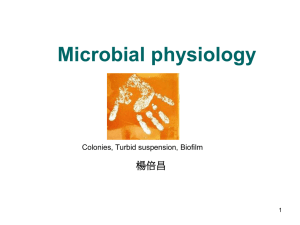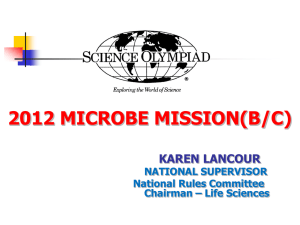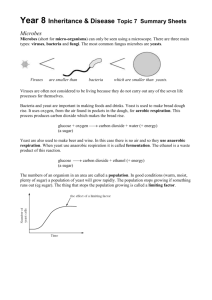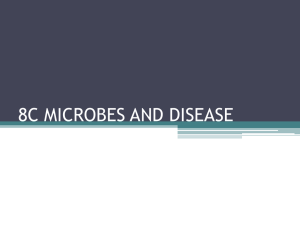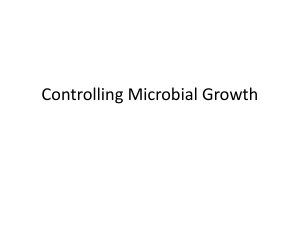Microbes: An Introduction - Lesson Plan for Middle School
advertisement
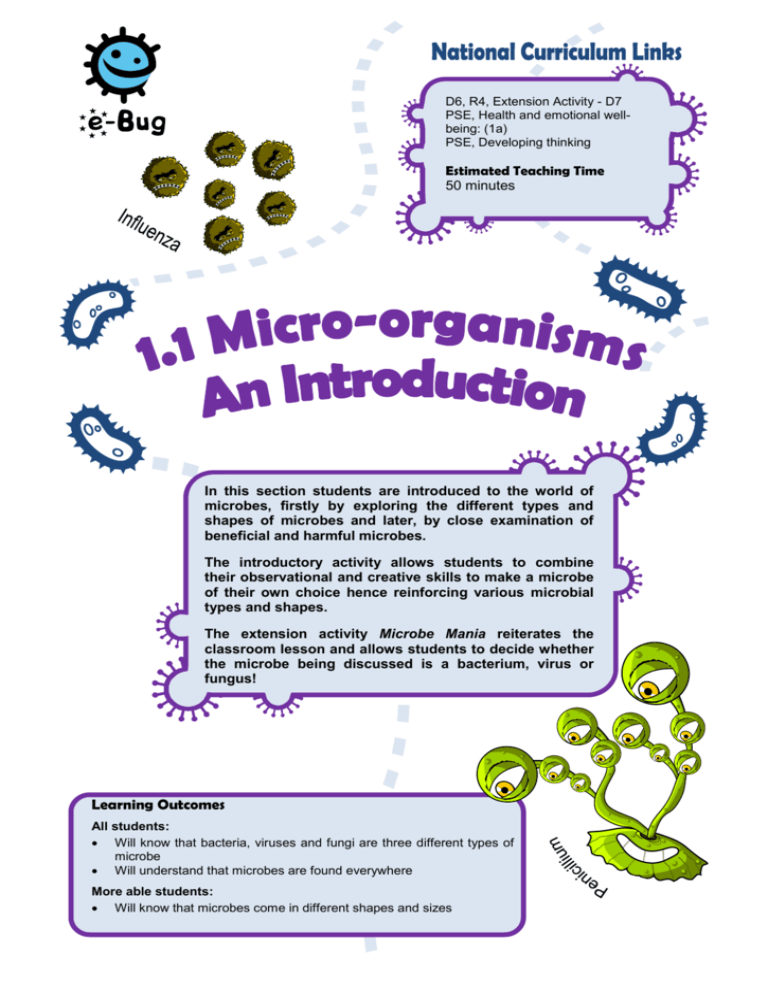
D6, R4, Extension Activity - D7 PSE, Health and emotional wellbeing: (1a) PSE, Developing thinking Estimated Teaching Time 50 minutes In this section students are introduced to the world of microbes, firstly by exploring the different types and shapes of microbes and later, by close examination of beneficial and harmful microbes. The introductory activity allows students to combine their observational and creative skills to make a microbe of their own choice hence reinforcing various microbial types and shapes. The extension activity Microbe Mania reiterates the classroom lesson and allows students to decide whether the microbe being discussed is a bacterium, virus or fungus! Learning Outcomes All students: Will know that bacteria, viruses and fungi are three different types of microbe Will understand that microbes are found everywhere More able students: Will know that microbes come in different shapes and sizes 1.1 Micro-organisms An Introduction Background Information Key Words Bacteria Bug Cell Disease Fungi Germ Microbe Micro-organism Microscope Pathogen Probiotic Viruses Materials Required Per Student A copy of SH 1 A copy of SW 1 A copy of SW 2 Petri dish (optional) Microbial images from www.e-bug.eu Per Group Play dough in a variety of colours (for home made recipe see TS 4) Available Web Resources A demonstration film of the activity A variety of microbial photographs FASCINATING FACT Antonie van Leeuwenhoek created the first ever microscope in 1676. He used it to examine various items around his home and termed the living creatures (bacteria) he found on scrapings from his teeth ‘animalcules’. Micro-organisms, also known as germs, bugs or microbes, are tiny living organisms too small to be seen with the naked eye. They are found almost everywhere on earth. Some microbes are beneficial and others can be harmful to humans (this will be explored in later sections). Although extremely small, microbes come in many different shapes and sizes. There are three main groups of microbes: Viruses are the smallest of the microbes and are generally harmful to humans. Viruses cannot survive by themselves. They need a ‘host’ cell in order to survive and reproduce. Once inside the host cell, they rapidly multiply and destroy the cell in the process! Fungi are multi cellular organisms that can be both beneficial and harmful to humans. Fungi obtain their food by either decomposing dead organic matter or by living as parasites on a host. Fungi can be harmful by causing infection or being poisonous to eat; others can be beneficial or harmless, e.g. Penicillium which produces the antibiotic penicillin. There are also fungi that are not microbes and some that can be eaten like Agaricus, commonly known as the white button mushroom. Bacteria are single-celled organisms that can multiply exponentially once every 20 minutes. During their normal growth, some produce substances (toxins) which are extremely harmful to humans and cause us disease (Staphylococcus); other bacteria are completely harmless to humans and others can be extremely useful to us (Lactobacillus in the food industry), some are even necessary for human life such as those involved in plant growth (Rhizobacterium). Harmless bacteria are called non-pathogenic, while harmful bacteria are known as pathogenic. Over 70% of bacteria are non-pathogenic. Bacteria can be simply divided into three groups by their shapes – cocci (balls), bacilli (rods) and spirals. Cocci can also be broken down into three groups by how the cocci are arranged: staphylococci (clusters), streptococci (chains) and diplococci (pairs). Scientists use these shapes to tell which infection a patient has. Advance Preparation Prepare a copy of SW 1 and SW 2 for each student. Prepare SH 1 poster for the classroom or on the white board. Purchase or follow the recipe in TS 4 to make play dough in a variety of colours. Download a variety of microbe images from www.e-bug.eu for student viewing. 1.1 Micro - organisms An Introduction Introduction 1. Begin the lesson by asking children what they already know about germs or bugs. Ask the children if they have, or anyone in their family, ever been sick? What was the disease and what do they think caused it? 2. Explain to the children that some diseases called infections are caused by germs and that these are tiny living organisms called microbes. Show the children that there are three different types of microbe: bacteria, viruses and fungi. Use the colour poster provided (SH 1), which is also found on the e-Bug website (www.e-bug.eu), for whiteboard presentation format. 3. Explain that these microbes are so small that they can only be seen through a microscope. Use the web activity or provide students with SH 2 to demonstrate the different sizes of microbes. 4. Emphasise that although some microbes cause disease, there are also beneficial microbes. Ask children to identify some useful microbes. If they cannot, provide examples for them e.g. Lactobacillus in yogurt and probiotics drinks, penicillin from fungi, etc. 5. Highlight to the class that microbes can be found EVERYWHERE: floating around in the air we breathe, on the food we eat, on the surface of our bodies, in our mouth, nose and gut/tummy. Main Activity 1. This activity can be done either individually or in groups. 2. Provide each group with either a colour handout (SH 1) of the different types of bacteria or place colourful posters on the classroom walls from the website www.e-bug.eu. These handouts will show the range of shapes and sizes of microbes with names and whether they are useful or harmful microbes. 3. Provide each group with play dough in a variety of colours, petri dishes and a copy of SW 1. 4. Ask each child / group to recreate a microbe or groups of microbes in their petri dish based on the coloured images provided. 5. Each child must decide whether or not they think their microbe is useful or harmful and provide its name. It is important to let the children get as creative as possible whilst taking into consideration the actual structure of microbes. 6. Remind the class that fungi are the largest microbes and viruses are the smallest. 7. If time permits, students can then present their microbes to the class. 1.1 Micro - organisms An Introduction Plenary Check for understanding by asking the children the following questions: 1. What are the most common types of microbe? There are three main types of microbe known as bacteria, viruses and fungi. 2. What are germs? A germ is another name used to describe a harmful microbe. 3. Where is a microbe found? Microbes are found EVERYWHERE, floating around in the air we breathe, on the food we eat, on the surface of our bodies, in our mouth, nose and gut/tummy. 4. Are all microbes harmful? No, although there are microbes which can be harmful to us there are also a lot of microbes that are very useful to us that we use every day, for example, Saccharomyces (fungi) is used to help bread rise, Lactobacillus (bacteria) help make yogurt and cheese. 5. What are the different shapes of bacteria? Spirals (Campylobacter), Rods (Lactobacilli) and Balls (Staphylococcus). Extension Activity 1. Provide each student with a copy of SW 2 and SH 1. 2. By reading the descriptions and using the information on their handouts students must decide whether the microbes are bacteria, virus or fungi. a. b. c. d. e. Staphylococcus is a bacterium. Lactobacillus is a bacterium. Dermatophytes are fungi. Influenza is a virus. Penicillium is a fungus. f. Campylobacter is a bacterium. 1.1 Micro - organisms An Introduction Play dough is a soft, pliable material that can keep children occupied for considerable lengths of time. Play dough is available to purchase under a range of different brand names but it may be cost effective to make your own. Home made play dough has the added advantage that you can choose your preferred palate of colours. The home made play dough is non-toxic, brightly coloured and easily sculpted making it an ideal tool for creative play and this activity. Ingredients 1 cup of plain flour 1 cup of water 1/2 cup of salt 2 tablespoons of cream of tartar 2 tablespoons of oil Food colouring Method Mix together the dry ingredients Add the water and mix until smooth Add the food colouring followed by the oil Cook on a medium heat, stirring constantly, until the dough leaves the side of the pan in a ball Allow to cool before use Microbes are living organisms They are so small we need a microscope to see them They come in different shapes and sizes There are They are found EVERYWHERE! Some microbes are useful or even good for us Some microbes can make us ill 3 different types of microbes: Penicillium Influenza Viruses are even smaller than bacteria and can sometimes live INSIDE bacteria! Some viruses make us sick. Diseases like CHICKENPOX and the FLU are caused by viruses. Viruses can spread from one person to another but it depends on the type of virus. Dermatophyte There are three different types of bacteria. They look like: Spirals Rods Balls (Campylobacter) (Lactobacillus) (Staphylococcus) They are so small that 1000s of bacteria could fit on the full stop at the end of this sentence. Some bacteria are helpful in cooking, for example, making yogurt and cheese. Some bacteria are harmful and cause infection. Fungi are the largest of all microbes. Fungi can be found in the air, on plants and in water. Mould, which grows on bread, is a type of fungus. Some antibiotics are made by fungi! 1. If you were as big as EUROPE... 3. A BACTERIUM would be the size of a BUS! 2. A FUNGUS would be the size of a football pitch! 4. A VIRUS would be the size of a FOOTBALL! Make your own Microbe Design a microbe of your choice, either a bacterium, a virus or a fungus using the materials provided. Before you start, decide if your microbe will be beneficial or harmful! Here are some pictures which might help! Bacteria Viruses Fungi Top Tip Bacteria come in lots of different shapes and sizes – some are round like balls, some are like spirals and some are long like rods. Some even use tail like structures to help them swim and move! 1. Is it a beneficial or harmful microbe? ______________________ 2. Choose a name for your microbe. ______________________ Fascinating Fact YOU are home to 1000 million microbes! This is a picture of my _________________________ There are 3 different types of microbe – bacteria, viruses and fungi. From the pictures and descriptions, can you work out which microbe is which? Hint Remember there are three different types of bacteria - rods spirals balls My name is Staphylococcus. I am round in shape and I like to live in your nose or armpit! If I live on your skin I can give you spots. If I get into your bloodstream I can make you ill! What am I? My name is Lactobacillus. People call me ‘friendly’ because I change milk into yogurt! When you eat me in yogurt I live in your guts and help you digest other food. What am I? I’m called a Dermatophyte and I like to live on your skin. I especially like living in damp places like between the toes on sweaty feet! When I live there I give people athlete’s foot! What am I? Staphylococcus is a: Lactobacillus is a: Dermatophytes are: ____________ ___________ ___________ My name is Influenza but my friends call me the ‘flu’. I’m very generous; I like to give people headaches and fever. I easily spread from person to person through coughing and sneezing. What am I? Influenza is a: My name is Penicillium and you’ll find me growing on old oranges or stale bread making them look mouldy. Humans use me to make an antibiotic known as Penicillin which can make them better, but only from bacterial infections! What am I? Penicillium is a: ___________ ___________ My name is Campylobacter. I have a pretty spiral shape and I like to live in chickens but if I get into your tummy I make you very ill – I can give you diarrhoea! What am I? Campylobacter is a: ___________


